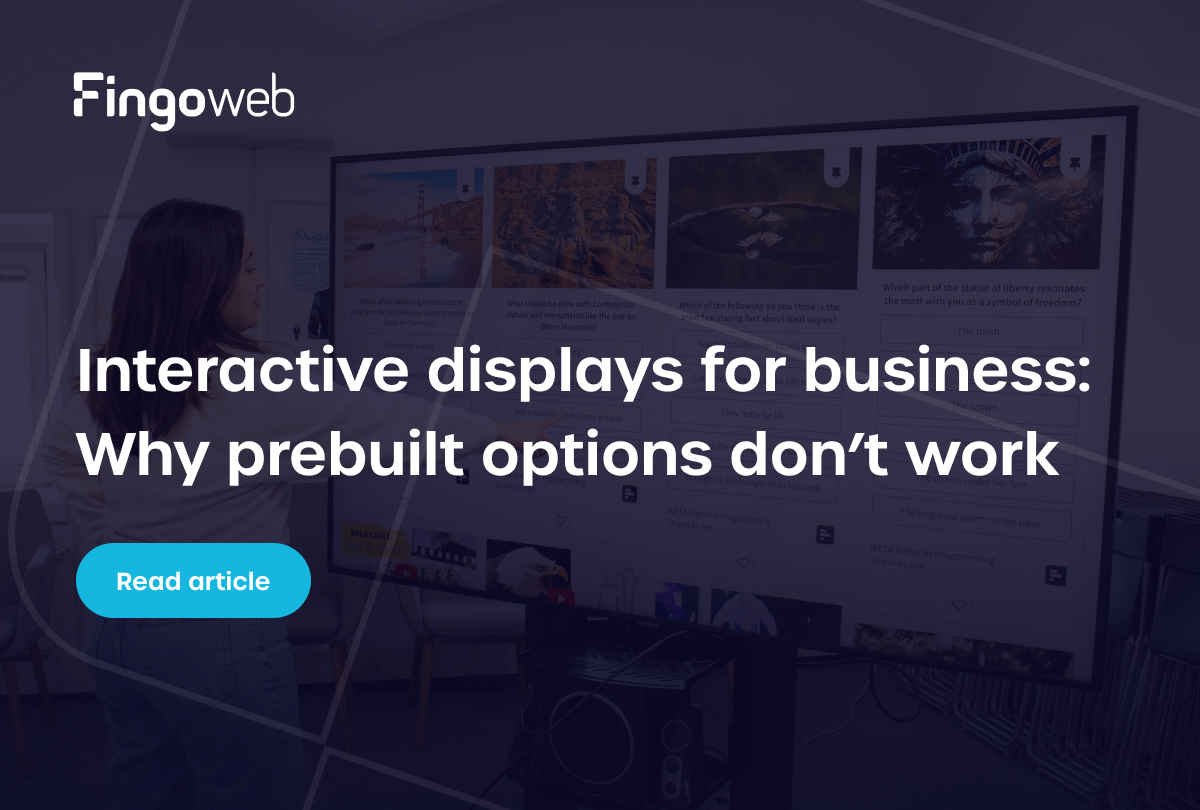1. Analysis of the website idea
Every project at Fingoweb starts with understanding your needs. That’s why before we even write a single line of code, we conduct a series of meetings with you, during which we discuss and clarify the scope and details of the solution. Idea analysis is the most crucial stage of the whole software development process because it defines the scope of activities of our team whose task is to meet your needs.
As a part of creating a strategic idea analysis we discuss such issues as:
- developing the purpose and scope of creating a dedicated solution,
- discussion of your requirements for the submitted project,
- analysis of available technological solutions,
- presentation of the general model of the system and external systems supporting the solution,
- cost estimation,
- signing a contract tailored to your needs, we offer contracts such as Time&Material, Fixed Price and Bodyleasing.
This stage ends when we are all sure that what we have done will last for years. The analysis ends with written documentation approved by both parties.
The most common mistakes that occur during the idea analysis stage are:
- Incorrectly defining the needs and goals that the solution is supposed to achieve;
- Focusing only on fragments of the system or a proposed solution, skipping many issues, which may contribute to delays in project implementation and to increased costs of service performance;
- Not taking into account the promotional and marketing aspects, useful in further phases of project development;
- Signing contracts that vaguely cover the terms of cooperation;
- Involvement of external persons who want to influence the project, causing communication and decision-making problems;
- Lack of prepared budget for project implementation.


2. UX & UI Design
To start the design process, we first analyse your customers and the needs they generate. Based on what we find out, we design functional mock-ups, which are sketches of the layout of a given website or system. The main purpose of using functional mock-ups is to be able to make changes and corrections before the work of the dedicated team, i.e. programmers, graphic designers and testers, begins. Thanks to this approach we are sure that the visual representation of the documentation will meet your expectations. After receiving your approval of the functional mock-up, we move on to the graphic design process. At this stage, you will receive 1 to 3 style lines along with RWD views. Our graphic designers will take care of the aesthetic look of your application and focus on the correct usability and functionality of the system. The next stage is to develop a prototype showing how the most important elements of the application work – this will allow us to present and refine the interaction, animation effects and responsiveness. Additionally, the prototype will facilitate the process of project development.
The most common mistakes that occur during the dedicated design stage are:
- Failure to adapt the size of text to the layout of the page, making the content unreadable to the viewer;
- Inappropriately matched colours, which garishly distract from the content on the page or in the system;
- Too many animations used, which can lose the user while navigating the site;
- Mixing of design styles, fonts and graphic icon families,
- Inconsistent styling of images or graphics;
- Breaking the hierarchy principle, which helps the user pay attention to the most important elements;
- Failure to communicate progress of ongoing work to the client.
- Lack of functional mock-ups consultation with tech lead, who is able to recognize if given solution proposed by graphic designer is within budget and contains assumptions created during analysis stage.

3. Delivery of the analysis to the software development company
A common solution used by clients is to order an idea analysis and layout design from a separate company which specializes in this type of service. After obtaining the developed guidelines, the client requests a valuation of developing the application or the site by a competitive company, which offers dedicated teams of developers. This solution has its pros and cons, which include:
Pluses:
- Reduced process for developers to provide a quote due to uploaded documents describing the scope and specifics of the activity;
- Good familiarity with the project by the client, which allows for clear communication between the parties;
- Payment only for the implementation of the project by the development team, omitting the costs of creating the analysis and design;
- Defined needs, goals and outlines of the project development, encourage its speed of implementation by the development team.
Minuses:
- Misunderstandings of programming expertise that can result from an inadequately refined idea analysis;
- Lack of familiarity of programmers with the process of creating analysis and graphic design by an external company, which may affect the efficiency of conducted orders;
- Incorrectly created analysis or graphic design, which affects the increase of costs in relation to the project;
- Lack of correct estimation of costs in relation to the order of programming the system or the website, which may result in customer disappointment
- Inability to implement the idea, due to unavailability of given technological solutions on the market;
- Extended communication channel between two separate project units that should cooperate within the project to maximize the effectiveness of the solution implementation.4. Development of a website, application or system
4. Software development of a website, application or system
At Fingoweb, we believe that the best solution for our clients is for the project to be taken care of by the chosen company that will take care of the development, design and implementation of the solution from A to Z. The process of coding a website is divided into the frontend and backend of the application. Of course, not every project has a need for both technical solutions, so as a team we adjust the available tools to the generated needs of the client.
Frontend is defined as a part of application or system, responsible for displaying and visualizing elements of the website to the user, taking into account their layout, behavior and animations.
The backend, on the other hand, is responsible for the entire structure of the application, being an invisible component to the user that allows data flow and manages the entire website system. Backend developers work with frontend developers to ensure the performance of the inner as well as outer layer of the web application. The goal of coding a website is to deploy it to the production environment so that the customer can fully use it on their own.
As part of the system implementation, the development team completes the following activities:
- Installation of the developed software on a test environment;
- Configuration of the software with the database;
- System start-up;
- Start testing the functionality of the solution, taking into account integration and migration of data and the operation of individual components of the application;
- Implementing a properly working system in the production environment;
- Providing the client with the system and data to the administration panel.
The most common errors that arise during the software development process are:
- Lack of sufficient number of specialists involved in the project;
- Communication failures within the team;
- Unconsidered way of creating a dedicated solution, which may result in many corrections in the work;
- Failure to determine the availability of developers within the framework;
- Failure to perform post production testing.
5. Hosting
If you decide to create your website or web application, you should also consider web hosting, which is embedding your website on an external computer server. Such an action guarantees continuous accessibility to the application, without the need to buy your own server. At Fingoweb, we practice cloud hosting, which, compared to traditional hosting, allows you to settle your application on multiple servers, guaranteeing data security and a backup plan in case one of the servers fails. What’s more, thanks to the so-called scalability, you can decide how much resources you need at any given time, making you pay only for what you use.
What parameters should I consider in order to choose the right hosting offer?
- Server Uptime – it is given as a percentage, informing about the number of times when the pages on the server are displayed correctly for the user, e.g. 99%;
- Disk space limit;
- Data processing speed;
- Price of the service.
6. Saving some funds for PR and Marketing
As you work out a budget for building a new website or supporting system, keep in mind the steps after its creation, specifically promotion and marketing. If you use all the funds for a technological solution, you may find at some point that the investment is not paying off. The reason may be the lack of spreading awareness among consumers about your new product or business initiative, which leads to stagnation of the organization development process. In this case it is necessary to optimize the content on your website, which affects the positioning of pages in search engines. This involves skillfully tailoring keywords in headings, meta descriptions and titles to increase the application conversions made by users. Another issue worth considering is creating online ads that will allow you to reach a specific group of users, triggering the required actions. External platforms and services can skillfully support your website's online visibility by distributing content customizing its form, purpose and audience.
You can carry out certain activities on your own, gaining knowledge from many free training courses and available resources on the Internet, or you can decide to use the services of a specialist or a marketing agency which will effectively promote your new product created by software house.
Common mistakes made during online marketing:
- Lack of created action strategy;
- Lack of developed target group of advertising messages;
- Skipping the stages of analysis and monitoring of actions performed;
- Spamming with sales ads, discouraging recipients to take action;
- Lack of attention to the quality of published content and promotional content;
- Using all available media on the market, without prior verification of the group of recipients;
- Lack of drawing conclusions from conducted advertising campaigns.
FAQ about software development processes
What is the purpose of the initial website idea analysis?
The idea analysis is essential to define the project's scope and requirements clearly. During this phase, Fingoweb works closely with clients to understand their goals, discuss technical possibilities, estimate costs, and finalize the project contract. This phase ensures that the project meets your needs effectively.
Can I use another company for the idea analysis and design stages, then bring it to Fingoweb for development?
Yes, you can. However, using separate companies may lead to:
- Misunderstandings due to unfamiliarity with technical details.
- Increased costs if the initial analysis or design is incorrect.
- Communication challenges between Fingoweb’s development team and the external design team.
How does Fingoweb handle software development?
Fingoweb provides complete end-to-end development, handling front-end (user interface) and back-end (application structure) coding to deliver a fully functional product. The process includes installing software, setting up databases, testing, and moving the system to a production environment for your use.
Does Fingoweb provide web hosting?
Yes, Fingoweb offers cloud hosting services, which allow your website to be hosted on multiple servers. This ensures higher uptime, data security, and scalability to adjust resources as needed.






